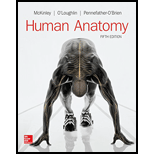
LooseLeaf for Human Anatomy
5th Edition
ISBN: 9781259285271
Author: Michael McKinley Dr., Valerie O'Loughlin, Elizabeth Pennefather-O'Brien
Publisher: McGraw-Hill Education
expand_more
expand_more
format_list_bulleted
Question
Chapter 5, Problem 4CR
Summary Introduction
To determine:
The three different types of hair produced during a person’s lifetime.
Introduction:
Hair is derived from epidermis and are made up of two distinct parts: the follicle and the hair shaft. The follicle is responsible for anchoring each hair to the skin, and the hair shaft is formed from hair bulb, and it consists of a cortex and cuticle cells, and a medulla for some types of hairs.
Expert Solution & Answer
Want to see the full answer?
Check out a sample textbook solution
Students have asked these similar questions
Please draw in the missing answer, thank you
Please fill in all blank questions, Thank you
please fill in missing parts , thank you
Chapter 5 Solutions
LooseLeaf for Human Anatomy
Ch. 5 - What are the two major layers of the integument...Ch. 5 - Prob. 2WYLCh. 5 - Why is the stratum spinosum important in...Ch. 5 - Briefly describe the process of keratinization....Ch. 5 - Prob. 5WYLCh. 5 - How do melanocytes help protect the skin?Ch. 5 - Briefly describe the structure of epidermal ridges...Ch. 5 - What is indicated by the lines of cleavage in the...Ch. 5 - Prob. 9WYLCh. 5 - Prob. 10WYL
Ch. 5 - Why does the lunula of the nail have a whitish...Ch. 5 - Prob. 12WYLCh. 5 - Compare and contrast merocrine and apocrine sweat...Ch. 5 - What do sebaceous glands secrete?Ch. 5 - What is the source of new epidermal cells and new...Ch. 5 - Why do skin repair processes take longer as we...Ch. 5 - What is the cause of increased sensitivity to the...Ch. 5 - Match each numbered item with the most closely...Ch. 5 - Prob. 1MCCh. 5 - Prob. 2MCCh. 5 - The sweat glands that communicate with skin...Ch. 5 - Which of the following is not a function of the...Ch. 5 - Prob. 5MCCh. 5 - Which statement is true about melanin and...Ch. 5 - Prob. 7MCCh. 5 - Prob. 8MCCh. 5 - Prob. 9MCCh. 5 - Water loss due to evaporation of interstitial...Ch. 5 - Prob. 1CRCh. 5 - Describe two ways in which the skin helps regulate...Ch. 5 - Prob. 3CRCh. 5 - Prob. 4CRCh. 5 - Prob. 5CRCh. 5 - Prob. 6CRCh. 5 - Describe how the skin is involved in vitamin D...Ch. 5 - Prob. 8CRCh. 5 - Prob. 9CRCh. 5 - Prob. 10CRCh. 5 - Prob. 1DCRCh. 5 - Prob. 2DCRCh. 5 - Prob. 3DCR
Knowledge Booster
Learn more about
Need a deep-dive on the concept behind this application? Look no further. Learn more about this topic, biology and related others by exploring similar questions and additional content below.Similar questions
- please draw in the answers, thank youarrow_forwarda. On this first grid, assume that the DNA and RNA templates are read left to right. DNA DNA mRNA codon tRNA anticodon polypeptide _strand strand C с A T G A U G C A TRP b. Now do this AGAIN assuming that the DNA and RNA templates are read right to left. DNA DNA strand strand C mRNA codon tRNA anticodon polypeptide 0 A T G A U G с A TRParrow_forwardplease answer all question below with the following answer choice, thank you!arrow_forward
- please draw in the answeres, thank youarrow_forwardA) What is being shown here?B) What is indicated by the RED arrow?C) What is indicated by the BLUE arrow?arrow_forwardPlease identify the curve shown below. What does this curve represent? Please identify A, B, C, D, and E (the orange oval). What is occurring in these regions?arrow_forward
- Please identify the test shown here. 1) What is the test? 2) What does the test indicate? How is it performed? What is CX? 3) Why might the test be performed in a clinical setting? GEN CZ CX CPZ PTZ CACarrow_forwardDetermine how much ATP would a cell produce when using fermentation of a 50 mM glucose solution?arrow_forwardDetermine how much ATP would a cell produce when using aerobic respiration of a 7 mM glucose solution?arrow_forward
- Determine how much ATP would a cell produce when using aerobic respiration to degrade one small protein molecule into 12 molecules of malic acid, how many ATP would that cell make? Malic acid is an intermediate in the Krebs cycle. Assume there is no other carbon source and no acetyl-CoA.arrow_forwardIdentify each of the major endocrine glandsarrow_forwardCome up with a few questions and answers for umbrella species, keystone species, redunant species, and aquatic keystone speciesarrow_forward
arrow_back_ios
SEE MORE QUESTIONS
arrow_forward_ios
Recommended textbooks for you
 Anatomy & PhysiologyBiologyISBN:9781938168130Author:Kelly A. Young, James A. Wise, Peter DeSaix, Dean H. Kruse, Brandon Poe, Eddie Johnson, Jody E. Johnson, Oksana Korol, J. Gordon Betts, Mark WomblePublisher:OpenStax College
Anatomy & PhysiologyBiologyISBN:9781938168130Author:Kelly A. Young, James A. Wise, Peter DeSaix, Dean H. Kruse, Brandon Poe, Eddie Johnson, Jody E. Johnson, Oksana Korol, J. Gordon Betts, Mark WomblePublisher:OpenStax College Human Biology (MindTap Course List)BiologyISBN:9781305112100Author:Cecie Starr, Beverly McMillanPublisher:Cengage Learning
Human Biology (MindTap Course List)BiologyISBN:9781305112100Author:Cecie Starr, Beverly McMillanPublisher:Cengage Learning Human Physiology: From Cells to Systems (MindTap ...BiologyISBN:9781285866932Author:Lauralee SherwoodPublisher:Cengage Learning
Human Physiology: From Cells to Systems (MindTap ...BiologyISBN:9781285866932Author:Lauralee SherwoodPublisher:Cengage Learning



Anatomy & Physiology
Biology
ISBN:9781938168130
Author:Kelly A. Young, James A. Wise, Peter DeSaix, Dean H. Kruse, Brandon Poe, Eddie Johnson, Jody E. Johnson, Oksana Korol, J. Gordon Betts, Mark Womble
Publisher:OpenStax College

Human Biology (MindTap Course List)
Biology
ISBN:9781305112100
Author:Cecie Starr, Beverly McMillan
Publisher:Cengage Learning

Human Physiology: From Cells to Systems (MindTap ...
Biology
ISBN:9781285866932
Author:Lauralee Sherwood
Publisher:Cengage Learning

The Integumentary System, Part 1 - Skin Deep: Crash Course Anatomy & Physiology #6; Author: CrashCourse;https://www.youtube.com/watch?v=Orumw-PyNjw;License: Standard youtube license